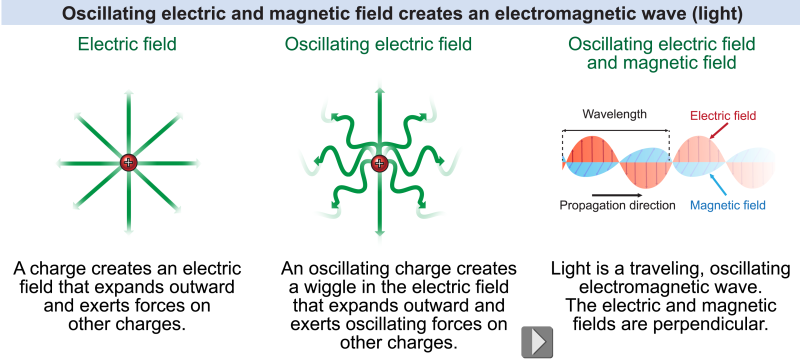|
When you look at sunlight streaming in through the window you probably don’t associate the light with mental images of electricity or magnets. You probably don’t think of atoms either. The nature of light was a mystery for thousands of years until physicists of the late 19th century discovered the connection among light, electricity, and magnetism. In the early 20th century physicists went further, connecting the emission and absorption lines of light to the properties of the atom (Chapter 26). 
|
Light and the oscillating electric field
|
In 1865, physicist James Clerk Maxwell developed a theory of electricity and magnetism that predicted the existence of traveling waves. He calculated the speed of these waves and found that it matched the speed of light. Based on this evidence, Maxwell made a strong argument that light was a form of electricity and magnetism. Just 24 years later, in 1889, Heinrich Hertz proved experimentally the existence of Maxwell’s electromagnetic waves and demonstrated conclusively that these waves had all the properties of light. 
 |
James Clerk Maxwell (1831–1879) was a Scottish physicist. The young James had very little formal schooling and, after his mother died when he was 8 years old, James attended boarding school at Edinburg Academy with his aunt Isabella. Having been raised in isolation on his father’s farm, James did not quite fit in at the prestigious but formal academy. Even though other students mocked his rural accent and clothes, he maintained his insatiable curiosity. While James initially pursued his artistic talent at drawing, his interests in natural phenomena ranged far and wide in mathematics, engineering, and science. He tinkered and experimented, relentlessly exploring curious things that caught his fancy. James published his first scientific paper at the age of 14, and he won both the school’s mathematics medal and the award for English poetry!
In 1856, James Clerk Maxwell went on to become the youngest holder (at age 25) of the Chair of Natural Philosophy at Aberdeen University, akin to being the department head at a university today. Maxwell’s contributions to physics span almost the entire range of the subject. His most famous achievement is the set of equations which unify light, electricity, and magnetism into a single theory eloquently stated with four equations named after him. He discovered the phenomenon of photoelasticity in which materials under stress alter the polarization of light. Along with Ludwig Boltzmann, Maxwell developed the kinetic theory of gases and established the foundation of the modern theory of heat and the phases of matter. In engineering and technology, Maxwell presented the first durable color photograph in 1861 and developed a theory for the analysis of the strength and rigidity of trusses. Trusses are used in bridges and many other forms of structures. Many physicists regard Maxwell as the 19th-century scientist having the greatest influence on 20th-century physics, ranking him with Newton and Einstein as among the most brilliant physicists of all time. 
|
Consider a stationary positive charge. The charge creates an electric field satisfying Coulomb’s law that reaches out in every direction and affects other charges. A negative charge nearby feels the electric force of attraction from the positive charge. Maxwell asked the following question: How fast does the force get from one charge to the other? 
|

|
In Chapter 18 we considered the electric field of static charges. Now, consider a positive charge that oscillates up and down. The charge’s motion creates a corresponding wiggle, or wave, in the electric field! That wave travels at the speed of light and causes distant charges to respond. An oscillating charge creates a traveling oscillation in the electromagnetic field that travels outward at the speed of light. 
|
Light is a traveling oscillation of the electromagnetic field. In the previous chapter we learned that a moving electric charge (current) creates a magnetic field. Therefore, the oscillating positive electric charge in the above example creates an oscillating magnetic field as well as an electric field. Once started, the electric field generates a magnetic field as it changes. The magnetic field in turn generates an electric field as it changes. The electric and magnetic fields propagate with each other in an electromagnetic wave. 
|
Light is made up of a combination of what two oscillating fields? - electric and magnetic
- magnetic and gravitational
- electric and gravitational
- soccer and baseball
 |
The correct answer is a, electric and magnetic. Oscillating electric and magnetic fields reinforce each other, and this drives their propagation. The moving field is light. 
|
| |
|

